Hanuman
Crouched Low on the slopes of Mount Mahendra, stretching out his tail and
fixing his eyes on the horizon. He remembered his father the Wind god and
prayed for his protection. Then he vowed, 'Either I shall find Sita or destroy
Lanka,' and leaped into the sky.
As he launched
himself the mountain shook, sending forth showers of fragrant flowers.
Thousands of trees were uprooted and swept into the sky, falling like a carpet
of stars into the sea. He flew through the air with his tail out behind him,
shining like the sun as he passed in and out of clouds. His eyes blazed and the
wind thundered past his ears while far below the sea tossed in his wake,
churning up waves as high as mountains.
Wishing
to help Hanuman, the Sea god sent the winged mountain Mainaka up from the
seabed to give him a resting place. But as the mountain, with its gold-tipped
peaks, rose before him, Hanuman simply thrust it aside with his chest. The gods
were thrilled at his prowess and wanted to see more of his splendour, so they
sent Surasa, mother of the Naga celestial snakes, to test him. She assumed a
gigantic form and rose from the ocean in front of Hanuman, with her mouth
outstretched to devour him. But Hanuman expanded his size, forcing her to open
her mouth wider, then shrank to the size of a thumb to enter and leave her
mouth in an instant, and continued on his way.
Next
came the sea-demoness Simhika, who had not eaten for years. When she saw
Hanuman flying above the sea, she used her magic powers to seize his shadow.
Hanuman felt himself' held back by some unseen influence and looked down,
seeing Simhika in the sea. He swept down towards her and she tried to swallow
him, but he again shrank to nothing and flew into her mouth. Penetrating deep
inside her, he burst out through her
heart and killed her instantly.
As he
neared the island of Lanka, Hanuman saw forests and mountains stretched out
below him, and in the distance Mount Trikuta, beside which stood the fabulous
city of Lanka, looking like the capital of heaven. He returned to his normal
size and touched down safely on the peak of Mount Trikuta. Not even short of
breath, he set off through the lush jungle towards the city. Soon he arrived at
the edge of the outer moat beneath towering walls and turrets of gold with
pennants fluttering in the breeze. He made his way to the northern gate where
he saw large numbers of guards and much coming and going. He lay hidden among
the trees until darkness fell.
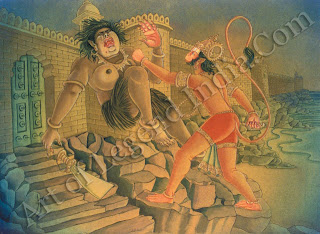 When
all was dark he shrank to the size of a cat and sprang over the battlements. By
the light of the full moon he followed the main highway into the city. Around
him were mansions of' gold inlaid with diamonds and pearls. Deep rumblings,
like the distant roar of' the ocean, came from the depths of the city, and here
and there bells tinkled. Suddenly he was challenged by a hideous female figure.
When
all was dark he shrank to the size of a cat and sprang over the battlements. By
the light of the full moon he followed the main highway into the city. Around
him were mansions of' gold inlaid with diamonds and pearls. Deep rumblings,
like the distant roar of' the ocean, came from the depths of the city, and here
and there bells tinkled. Suddenly he was challenged by a hideous female figure.
'Who
are you and what do you want?' she demanded.
'First
tell me who you are,' Hanuman replied.
'My
name is Lanka, the guardian spirit of this city, and I am aware of all that
goes on here. No one can wander about this city without my sanction.'
'It is
my wish to see around Lanka and I shall do as I please,' retorted Hanuman.
Not
without overcoming me,' she cried, and struck Hanuman on the face. In
retaliation he felled her to the ground with a slap.
'Spare
me,' she begged. 'I was once told by Brahma that when a monkey enters Lanka and
overpowers me, the defeat of' all the rakshasas who live here will soon follow.
I give you permission to go wherever you please and assure you that you will
accomplish your purpose, and in so doing bring about the destruction of
Ravana.'
Hanuman
continued on his way. Soon he heard laughter and music and saw on the streets
people of all kinds. Some were ugly, others beautiful, some coarse, others
refined. He saw scholars and priests, powerful warriors and drunken fools.
Naked ascetics with shaven heads muttered malevolent spells and eyed him
curiously as he passed, while monstrous demons with deformed features and
misshapen bodies guarded doorways along the way, armed with swords, clubs and
spears.
After
passing many mansions and crossing wide avenues, Hanuman came to the outer
gates of Ravana's palace, made of solid gold embellished with precious gems.
Inside was a city within a city, filled with mansions of gold and silver,
teeming with demons strutting here and there, challenging each other in proud
tones, singing boisterously or lying in drunk-en stupor. He also saw noble
beings, hand-some and graceful, dressed in finery and shining brightly.
Entering
the inner palace, Hanuman passed armed guards mounted on chariots and throngs
of courtiers in avenues vibrant with the sound of kettledrums and trumpets. He
came upon rakshasa women, some bashful, some alluring all exceptionally
beautiful. He looked at them all closely, hoping to find Sita, but saw her
nowhere.
He
ranged among the houses of Ravana's generals and ministers, and his brothers
Kumbhakarna and Vibhisana. He passed Ravana's stables, which housed mighty war
elephants and horses of many colours, and then he entered gardens and pleasure
grounds resounding with the cries of peacocks and sparkling with heaps of gems.
Finally
he reached Ravana's personal residence. Blazing with jewels, it was a palace.
of such splendour it seemed as if heaven had come down to earth. In its inner
courtyard was moored the fabulous Puspaka airplane, like a mountain, with domes
clustered one above another. This was the airplane that Ravana had stolen from
Kuvera, the treasurer of the gods, and was his proudest possession. It was
built from gold, silver, coral and crystal; yet it hovered weightless above the
ground. Hanuman slipped aboard, up stairways of' gems, through pillared halls
laid with crystal and lit by emeralds and sapphires. Fountains played in lotus
pools surrounded by groves of artificial trees and flowers. The Puspaka was
capable of travelling at the speed of mind along cosmic pathways. It was imbued
with a mind of' its own, which responded to the thoughts of its commander, who
must have exceptional power in order to control it. Hanuman scoured all the chambers
and hallways on its many levels, but did not find Sita.
From
there he stole into Ravana's private apartments where he saw bevies of'
gorgeous women deep in slumber, exhausted from their revelries, their limbs and
coverings in disarray. With their heads pillowed on one another's breasts and
arms, their garlands and necklaces scattered, and their breath perfumed by
fragrant wines, they looked like swans floating on a sea of lotus flowers.
Lamps burned dimly, held by sentinels of gold who watched silently over the
fair assembly.
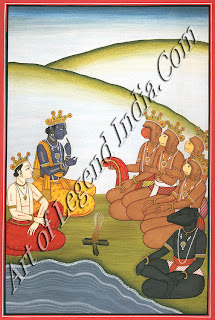 In the
midst of this scene was a raised bedstead of ivory and gold beneath a white
canopy where Ravana slept, fanned by female attendants. His powerful arms,
encircled with gold bracelets and flashing with diamonds, revealed the scars
of' many battles. Around his bed slept female musicians, still holding their
musical instruments in sensuous embrace.
In the
midst of this scene was a raised bedstead of ivory and gold beneath a white
canopy where Ravana slept, fanned by female attendants. His powerful arms,
encircled with gold bracelets and flashing with diamonds, revealed the scars
of' many battles. Around his bed slept female musicians, still holding their
musical instruments in sensuous embrace.
On a
richly upholstered bed nearby lay a fair-complexioned woman more gorgeous than
the others. At first Hanuman thought her to be Sita, but then he realized this
could not be so; Sita would never surrender herself to be enjoyed by Ravana.
This woman must be Ravana's queen, Mandodari, who had been given to him as a
young girl by her father, the demon Maya. Since then Ravana had carried off
thousands of other young girls from the homes of' gods and celestial beings,
all of whom were allured by his power and sexual energy. Sita, however, was the
one woman who would never submit to his will.
Continuing
his search, Hanuman entered the dining hall, where meats such as peacock,
rhinoceros and porcupine stood untouched or half-consumed on golden dishes. The
floor was scattered with broken cups and bowls amid piles of disordered
cushions, pools of juice and half-finished cups of wine.
Leaving
the palaces, Hanuman scoured the open spaces surrounding them. He looked among
the crowds at crossroads, in narrow lanes, in chasms and ravines, but not
seeing Sita anywhere, he began to fear the worst. Perhaps she had fallen into
the sea as she was carried to Lanka, or been set upon by the demon women in
Ravana's employ, or had died from a broken heart in separation from her lord.
In despondency Hanuman decided to hide somewhere and fast to death, his mission
having failed.
Just
then he came across a grove of ancient ashok trees that he had not noticed
before, hidden beneath a wooded hilltop beside Ravana's palace. This was
Ravana's private retreat and something told Hanuman it might be the place where
he would find Sita. He prayed to Vishnu to give him success, and leaped over
the boundary wall. Inside, the trees were thick with flowers and entwined with
climbers. As the monkey jumped from one tree to another they scattered their
blossoms, covering him with petals so that he looked like the spirit of'
spring. Advancing deeper into the grove he found that the trees took on a
silver hue, and their flowers became richer and more perfumed. Water tumbled
down the hillside into a crystal-clear pool with a white sandy bed sparkling
with gems and corals. Around the pool, marble steps descended from among trees
of gold that chimed as if with tiny bells in the breeze. Hanuman climbed the
tallest tree and peered out from its branches across the moonlit landscape.
Nearby was a tree greater and more venerable that all the others. Beneath it he
saw a woman seated on the ground dressed in torn unwashed clothes. She was pale
and drawn and her face was bathed in tears, but her beauty shone like the moon
through a veil of clouds.
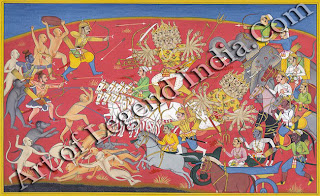 Hanuman
knew her to be the same woman he had seen carried over Rishyamukha Hill by
Ravana, and he recognized the ornaments she wore as matching the ones cast down
from the sky to the monkeys that day, and her yellow robe as matching the silk
cloth in which they had been wrapped. She must be Sita.
Hanuman
knew her to be the same woman he had seen carried over Rishyamukha Hill by
Ravana, and he recognized the ornaments she wore as matching the ones cast down
from the sky to the monkeys that day, and her yellow robe as matching the silk
cloth in which they had been wrapped. She must be Sita.
Around
her demonesses circled restlessly, hideous in appearance, carrying clubs or
spikes. Some had only one eye and misshapen features, some were covered in
hair, some were hump-backed or monstrous in size, with heads of goats, camel's
feet or donkey's ears. In the midst of these monsters, Sita was weighed down by
grief, like a boat sinking beneath its load.
How can
such a blameless and exalted soul as Sita be afflicted with so much sorrow?'
lamented Hanuman. 'Indeed it is hard to understand destiny. Yet I see she is
forbearing as the earth from whom she was born. She does not see the monsters
surrounding her, or this heavenly garden. She sees only Rama.
The Ring
As dawn
approached Hanuman heard the distant sound of the sacred hymns of the Vedas
being chanted in the city. At Ravana's bedside musicians serenaded him and
slowly the great demon stirred, his head heavy with drink. His first thought
was of Sita. Although he was powerful beyond measure, Ravana was the slave of
passion, and at the moment all his passion was focused on Sita. Dressing and
perfuming himself, he set off to the ashok grove followed by a procession of
female attendants bearing torches in the early dawn light. As it passed through
the glades echoing with birdsong, the procession looked like the progress of
the god of love.
Hidden
among the branches, Hanuman watched as Ravana approached. As soon as she saw
him, Sita huddled up in modesty and shook with fear. Although she was
distressed and forlorn, she could not hide her flawless beauty, which shone
like the moon through the clouds. Hanuman was amazed to see the mighty Ravana
actually prostrate himself full-length on the ground before her.
Have no
fear, sweet lady, no other demons lurk here. It is only I, begging for your
love,' came Ravana's love-stricken words. 'My soul is ravished by you. Please
return my love. It is the habit of us demons to seduce other's wives by force,
but I have restrained from this for ten months, waiting for you to willingly
give yourself to me.
Your
beauty holds me entranced. The creator, after fashioning you, must have
retired, having surpassed all else. Though you are covered in torn cloth with
your hair in a single plait, you make me forget even my consort Mandodari. My
thousands of' other wives will wait upon you. Why do you think only of' Rama, a
mere man? He is nothing compared to me. Untold wealth can be yours. Just be
minel
Take
your mind off me and be satisfied with your nettny wives, Sita responded
fiercely. 'You should protect me, not seek to molest me. Your infatuation will
destroy your kingdom and all who live in it. I belong to Rama as the sunshine
belongs to the sun. You will never have me. Soon Rama will be here with arrows
of fire to destroy you. You cannot flee he will find you wherever you are.
It
seems, good lady, that the more I speak sweet words to you the more unkind you
become. Very well, be warned; you have two months to surrender to me. If you
refuse to share my bed after that time, you will be minced up and I will eat
you for my breakfast!' These foul words upset many of Ravana's women, whom he
had won from among gods or pious families. They tried to reassure Sita with
secret glances. But she continued fearlessly.
You
have no friends here, otherwise they would advise you that you bring upon
yourself your own destruction by stealing another's wife, not to speak of the
wife of' Rama. I wonder that your tongue has not fallen out, or your eyes been
blinded. I am here for your destruction. Touch me at your peril.' Ravana's face
twisted and he raised Ahand to strike Sita, but was restrained by his women,
who dragged him away. Sport with us, lord, and havelinthing more to do with
this Sita,' they implored. 'Do with her agsi-You will to force her to her
senses,' he shouted at those around Sita. Angry and humiliated, he left4Now the
demonesses came forward, first cajoling, then taunting, threatening Sita with
their weapons.
Don't
you know what you are turning down? You have been loyal to your husband, now do
the sensible. Ravana has vanquished the entire universe. The thirty-three high
gods and even Indra himself are under his sway, and now he wishes to give up
his wife Mandodari in favour of you. You are mad to refuse.'
I would
like to taste her liver,' snarled one, 'and her heart, too.' 'Why should we
wait?' cried another. 'Divide her up now and cook her.' 'I will never be his
wife,' Sita retorted. 'I am human, and he is a rakshasa and I will never have
anything to do with the monster. You can eat me if you like, I don't care.
Shuddering
with emotion she withdrew towards the tree in which Hanuman was concealed. 'I
would not touch that despicable Ravana even with my left foot. Why can I not die
now? Then I would be shamed no more.
If Rama would come, he would kill Ravana and
destroy this entire city. Then it will be you who weep, your husbands dead. He
will destroy you all.' an old rakshasa woman, named Trijata, awoke just then.
Seeing that the other rakshasas were tormenting Sita, she stopped them.'
Eat one
another if you like, but you will never eat her. I have had a dream,' she
murmured, 'I saw Rama, dressed in shining white, riding with Sita on a great
white elephant. Then I saw Ravana and his brothers, their heads shaven, riding
south on mules, laughing hideously. Next I saw a powerful monkey set fire to
the city or Lanka which fell crashing into the waves, while the women of the
city laughed in madness.
My
advice to you is stay away from her and leave this place if you can.
Her
companions fell silent and sat down listlessly, not caring enough to argue.
Sita crept further into the hollow of the tree beneath Hanuman. Fingering the
cord tying her hair, she thought of suicide.
Hanuman
desperately wanted to reassure Sita. But how could he do so without frightening
her? She would think he was just another of Ravana's tricks. He decided to talk
in Sanskrit, the human language spoken in Ayodhya. Softly, he spoke of Rama.
'There was once a mighty emperor in the line of Iksvaku called Dasaratha, who
had a son named Rama,' he began, and went on to recite the tale of Rama's
exploits up to the time that Sita was carried away.
In
search of Sita, Rama and Lakshmana journeyed south where they met with Sugriva,
lord of the monkeys. In alliance with him a great search for Sita was begun,
bringing me to Lanka where I have at last found her. Even now, Rama is waiting
for me to bring back news so that he can rescue her.
In
rapture, Sita listened to this mysterious voice, thinking at first it was just
a dream. She looked here and there until she caught sight of Hanuman in the
tree above her. Was this an apparition? How could a monkey talk, and know all
these details of her history?
Writer – Ranchor Prime
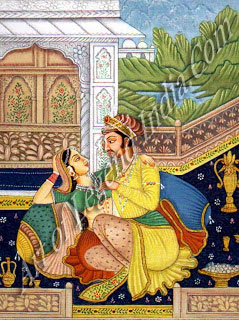 Radha
makes her debut as Krishna's chief consort in the Gitagovinda. Previously she
was known only from sporadic literary and epigraphical references, beginning in
the seventh century. Radha is absent from the major early texts in which the
life of Krishna is related: the Bhagavatapurana, Harivamsa,and
Vishnupurana. In these earlier texts, Krishna dallies with an anonymous group
of cowherdesses (gopis) rather than a favorite lover. As a result of the
exclusive emphasis accorded Radha in the Gitagovinda, her fame and popularity
grew so powerful that one sect, the Radhavallabhis founded in the sixteenth
century at Brindavan near Mathura, regarded her as supreme over Krishna and to
be the cosmic source of his divine energy.
Radha
makes her debut as Krishna's chief consort in the Gitagovinda. Previously she
was known only from sporadic literary and epigraphical references, beginning in
the seventh century. Radha is absent from the major early texts in which the
life of Krishna is related: the Bhagavatapurana, Harivamsa,and
Vishnupurana. In these earlier texts, Krishna dallies with an anonymous group
of cowherdesses (gopis) rather than a favorite lover. As a result of the
exclusive emphasis accorded Radha in the Gitagovinda, her fame and popularity
grew so powerful that one sect, the Radhavallabhis founded in the sixteenth
century at Brindavan near Mathura, regarded her as supreme over Krishna and to
be the cosmic source of his divine energy. +c.+1503-05.jpg) There are many companies online that deal just with oil
reproductions. Aside from these web based specialty companies, you may also
make contact with local specialty art training institutes. These training
institutes will invariably have students who're prepared to paint copies and
convey oil reproductions for purchasers at nominal fees. However, as these are
made by students, there isn't any real guarantee about cost and quality.
There are many companies online that deal just with oil
reproductions. Aside from these web based specialty companies, you may also
make contact with local specialty art training institutes. These training
institutes will invariably have students who're prepared to paint copies and
convey oil reproductions for purchasers at nominal fees. However, as these are
made by students, there isn't any real guarantee about cost and quality. The
paintings at Tiruvanchikulam, at Pallimanna, at Triprayer, in the Vadakkunatha
temple at Trichur and in the Mattancheri palace constitute a rich heritage from
the Cochin area, while those from Vaikom, Ettumanur, Chitaral, etc., having a
culmination in the famous paintings from the Padmanabhapuram and Krishnapuram
palaces, provide a picture of the painter's art in Travancore area. The mouth
is rather wide and the eyes have side-long looks, the body-build is heavy and a
smile is evident on the lips of all the figures of this school. Minute details
of dress and habits can be studied here. The top-knot of the Nambudiris and the
triple lamp so common in Malabar are all present. The scenes from the Ramayana,
the Mahabharata and the Puranas, including iconographic themes chosen by the
painters for portrayal, like the incident of Kumbhakarna gobbling the monkeys so
tiny as to escape through his nostrils and ears, are examples of the painters'
novel choice of comparatively insignificant but nevertheless interesting
scenes.
The
paintings at Tiruvanchikulam, at Pallimanna, at Triprayer, in the Vadakkunatha
temple at Trichur and in the Mattancheri palace constitute a rich heritage from
the Cochin area, while those from Vaikom, Ettumanur, Chitaral, etc., having a
culmination in the famous paintings from the Padmanabhapuram and Krishnapuram
palaces, provide a picture of the painter's art in Travancore area. The mouth
is rather wide and the eyes have side-long looks, the body-build is heavy and a
smile is evident on the lips of all the figures of this school. Minute details
of dress and habits can be studied here. The top-knot of the Nambudiris and the
triple lamp so common in Malabar are all present. The scenes from the Ramayana,
the Mahabharata and the Puranas, including iconographic themes chosen by the
painters for portrayal, like the incident of Kumbhakarna gobbling the monkeys so
tiny as to escape through his nostrils and ears, are examples of the painters'
novel choice of comparatively insignificant but nevertheless interesting
scenes. The
principal centre of Pahari painting was the Kangra Valley where the artists
worked under the patronage of the Hill Rajas of Guler, Kangra and Nurpur. From
here the artists migrated to the neighbouring States of Mandl, Suket, Kulu,
Tehri and Garhwal in the cast and Basohli and Chamba in the north. The art of
these States was but an off-shoot of the art of Kangra and the most appropriate
name for this version of Rajput art is the "Kangra Valley School of
Painting".
The
principal centre of Pahari painting was the Kangra Valley where the artists
worked under the patronage of the Hill Rajas of Guler, Kangra and Nurpur. From
here the artists migrated to the neighbouring States of Mandl, Suket, Kulu,
Tehri and Garhwal in the cast and Basohli and Chamba in the north. The art of
these States was but an off-shoot of the art of Kangra and the most appropriate
name for this version of Rajput art is the "Kangra Valley School of
Painting". 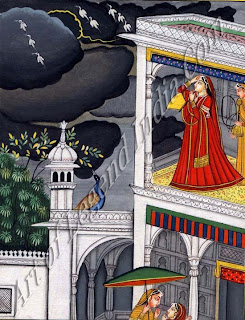 The
Raja is seated on a terrace listening to the music of drums and pipes. Terraces
of this nature can be seen in the Haripur-Guler Fort overlooking the Ranganga.
It is a key painting which marks the transition of the Mughal into the Kangra
style. Describing this painting, J. C. French observes: "The Raja is
listening to music, and the air of gentle reverie is well expressed. The pose
of the individual figures and the balance of the whole is admirable. In this
respect it resembles the finest of the Mogul paintings, but it has a delicacy
and a spirituality of feeling to which the Mogul art never attains. The
coloring of Kangra pictures of this period is extraordinarily delicate. The
Kangra artist had the colours of the dawn and the rainbow on his
palette."The role of Guler in the evolution of the Kangra style is thus
summed up by Dr. Archer:
The
Raja is seated on a terrace listening to the music of drums and pipes. Terraces
of this nature can be seen in the Haripur-Guler Fort overlooking the Ranganga.
It is a key painting which marks the transition of the Mughal into the Kangra
style. Describing this painting, J. C. French observes: "The Raja is
listening to music, and the air of gentle reverie is well expressed. The pose
of the individual figures and the balance of the whole is admirable. In this
respect it resembles the finest of the Mogul paintings, but it has a delicacy
and a spirituality of feeling to which the Mogul art never attains. The
coloring of Kangra pictures of this period is extraordinarily delicate. The
Kangra artist had the colours of the dawn and the rainbow on his
palette."The role of Guler in the evolution of the Kangra style is thus
summed up by Dr. Archer:  The
flowing and graceful curves of Kangra art form rhymes and assonances. The eye
moves with ease and comfort from one point to another enjoying delightful
rhythms and harmonies and the restful beauty of the curve.
The
flowing and graceful curves of Kangra art form rhymes and assonances. The eye
moves with ease and comfort from one point to another enjoying delightful
rhythms and harmonies and the restful beauty of the curve.  These
love-pictures display considerable intensity of feeling and are works of real
beauty. Life in the foot-hills of the Himalayas was full of danger and
insecurity, and death lurked not only on the battle-field but also in the thick
forests that covered the area. Women were greatly relieved when their husbands
came home safely, and their meeting was all the more intense for its
uncertainty.
These
love-pictures display considerable intensity of feeling and are works of real
beauty. Life in the foot-hills of the Himalayas was full of danger and
insecurity, and death lurked not only on the battle-field but also in the thick
forests that covered the area. Women were greatly relieved when their husbands
came home safely, and their meeting was all the more intense for its
uncertainty. 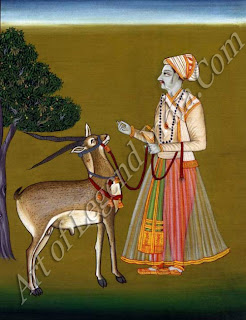 In
Tiruvannamalai, Tiruvottiyur, Tiruvalanjuli and other places, there are similar
representations of legends of Siva and scenes from the Ramayana and the
Mahabharata.
In
Tiruvannamalai, Tiruvottiyur, Tiruvalanjuli and other places, there are similar
representations of legends of Siva and scenes from the Ramayana and the
Mahabharata.  The
text above the painting identifies it as Gauri Ragini, a wife of Malkos Raga,
and describes the dark complexion and beautiful face of the heroine. The text
also gives the musical scale of the Ragini. Gauri Ragini is an evening melody
of autumn. Its alternate names, Gaudi and Gaudika, suggest that it may have
originated in Ganda (West Bengal). Representations of Gauri Ragini in the
Rajasthani and, as shown here, Amber traditions typically portray a lady
walking in the forest carrying two flower-wands and often accompanied by two
peacocks.
The
text above the painting identifies it as Gauri Ragini, a wife of Malkos Raga,
and describes the dark complexion and beautiful face of the heroine. The text
also gives the musical scale of the Ragini. Gauri Ragini is an evening melody
of autumn. Its alternate names, Gaudi and Gaudika, suggest that it may have
originated in Ganda (West Bengal). Representations of Gauri Ragini in the
Rajasthani and, as shown here, Amber traditions typically portray a lady
walking in the forest carrying two flower-wands and often accompanied by two
peacocks.  When
all was dark he shrank to the size of a cat and sprang over the battlements. By
the light of the full moon he followed the main highway into the city. Around
him were mansions of' gold inlaid with diamonds and pearls. Deep rumblings,
like the distant roar of' the ocean, came from the depths of the city, and here
and there bells tinkled. Suddenly he was challenged by a hideous female figure.
When
all was dark he shrank to the size of a cat and sprang over the battlements. By
the light of the full moon he followed the main highway into the city. Around
him were mansions of' gold inlaid with diamonds and pearls. Deep rumblings,
like the distant roar of' the ocean, came from the depths of the city, and here
and there bells tinkled. Suddenly he was challenged by a hideous female figure.
 In the
midst of this scene was a raised bedstead of ivory and gold beneath a white
canopy where Ravana slept, fanned by female attendants. His powerful arms,
encircled with gold bracelets and flashing with diamonds, revealed the scars
of' many battles. Around his bed slept female musicians, still holding their
musical instruments in sensuous embrace.
In the
midst of this scene was a raised bedstead of ivory and gold beneath a white
canopy where Ravana slept, fanned by female attendants. His powerful arms,
encircled with gold bracelets and flashing with diamonds, revealed the scars
of' many battles. Around his bed slept female musicians, still holding their
musical instruments in sensuous embrace.  Hanuman
knew her to be the same woman he had seen carried over Rishyamukha Hill by
Ravana, and he recognized the ornaments she wore as matching the ones cast down
from the sky to the monkeys that day, and her yellow robe as matching the silk
cloth in which they had been wrapped. She must be Sita.
Hanuman
knew her to be the same woman he had seen carried over Rishyamukha Hill by
Ravana, and he recognized the ornaments she wore as matching the ones cast down
from the sky to the monkeys that day, and her yellow robe as matching the silk
cloth in which they had been wrapped. She must be Sita.